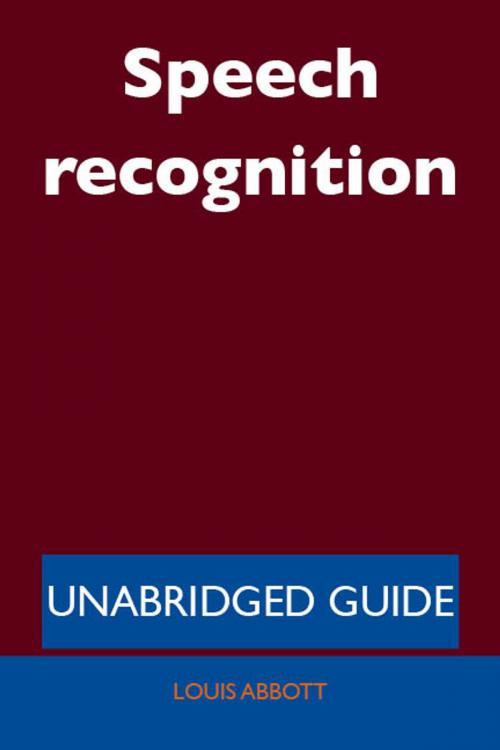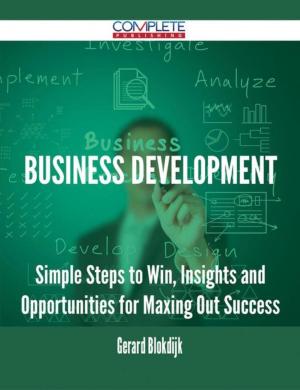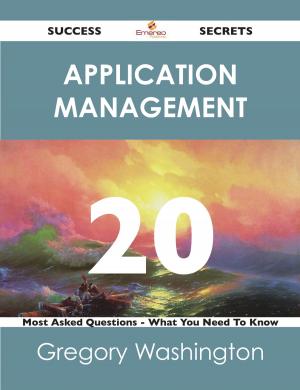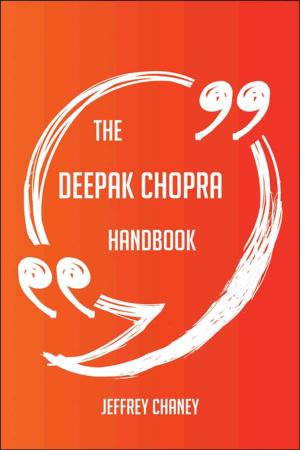| Author: | Abbott Louis | ISBN: | 9781486430383 |
| Publisher: | Emereo Publishing | Publication: | October 24, 2012 |
| Imprint: | Emereo Publishing | Language: | English |
| Author: | Abbott Louis |
| ISBN: | 9781486430383 |
| Publisher: | Emereo Publishing |
| Publication: | October 24, 2012 |
| Imprint: | Emereo Publishing |
| Language: | English |
Here's part of the content - you would like to know it all? Delve into this book today!..... : Speech recognition applications include voice user interfaces such as voice dialing (e. g. , Call home), call routing (e. g. , I would like to make a collect call), domotic appliance control, search (e. g. , find a podcast where particular words were spoken), simple data entry (e. g. , entering a credit card number), preparation of structured documents (e. g. , a radiology report), speech-to-text processing (e. g. , word processors or emails), and aircraft (usually termed Direct Voice Input).
...Each word, or (for more general speech recognition systems), each phoneme, will have a different output distribution; a hidden Markov model for a sequence of words or phonemes is made by concatenating the individual trained hidden Markov models for the separate words and phonemes.
...A typical large-vocabulary system would need context dependency for the phonemes (so phonemes with different left and right context have different realizations as HMM states); it would use cepstral normalization to normalize for different speaker and recording conditions; for further speaker normalization it might use vocal tract length normalization (VTLN) for male-female normalization and maximum likelihood linear regression (MLLR) for more general speaker adaptation.
... Decoding of the speech (the term for what happens when the system is presented with a new utterance and must compute the most likely source sentence) would probably use the Viterbi algorithm to find the best path, and here there is a choice between dynamically creating a combination hidden Markov model, which includes both the acoustic and language model information, and combining it statically beforehand (the finite state transducer, or FST, approach).
There is absolutely nothing that isn't thoroughly covered in the book. It is straightforward, and does an excellent job of explaining all about Speech recognition in key topics and material. There is no reason to invest in any other materials to learn about Speech recognition. You'll understand it all.
Inside the Guide: Speech recognition, Xuedong Huang, Word error rate, Windows Speech Recognition, VoxForge, Voice user interface, Voice recognition, VoiceXML, Viterbi algorithm, Transcription (linguistics), Technological singularity, Speech verification, Speech technology, Speech synthesis, Speech recognition in Linux, Speech processing, Speech perception, Speech interface guideline, Speech corpus, Speech analytics, Speech-to-text reporter, Speaker recognition, Speaker diarisation, Sensory, Inc., Robotics, Robot Interaction Language, Real time factor, Phonetic search technology, Outline of technology, Outline of artificial intelligence, Nuance Communications, Natural language processing, Multimodal interaction, Multimedia Information Retrieval, Microphone, Mars Polar Lander, Manfred R. Schroeder, Machine learning, LumenVox, Lifeline (video game), Lawrence Rabiner, Language model, Kinect, Keyword spotting, Jott, Interactive voice response, Hidden Markov model, Hands-free computing, HTK (software), Eurofighter Typhoon, Dynamic time warping, Digital dictation, DARPA, Constructed language, Computer engineering, Computational finance, Carnegie Mellon University, Cache language model, Audio mining, Audio-visual speech recognition, Artificial intelligence, Articulatory speech recognition, Applications of artificial intelligence, Andrew Sears, Acoustic model
Here's part of the content - you would like to know it all? Delve into this book today!..... : Speech recognition applications include voice user interfaces such as voice dialing (e. g. , Call home), call routing (e. g. , I would like to make a collect call), domotic appliance control, search (e. g. , find a podcast where particular words were spoken), simple data entry (e. g. , entering a credit card number), preparation of structured documents (e. g. , a radiology report), speech-to-text processing (e. g. , word processors or emails), and aircraft (usually termed Direct Voice Input).
...Each word, or (for more general speech recognition systems), each phoneme, will have a different output distribution; a hidden Markov model for a sequence of words or phonemes is made by concatenating the individual trained hidden Markov models for the separate words and phonemes.
...A typical large-vocabulary system would need context dependency for the phonemes (so phonemes with different left and right context have different realizations as HMM states); it would use cepstral normalization to normalize for different speaker and recording conditions; for further speaker normalization it might use vocal tract length normalization (VTLN) for male-female normalization and maximum likelihood linear regression (MLLR) for more general speaker adaptation.
... Decoding of the speech (the term for what happens when the system is presented with a new utterance and must compute the most likely source sentence) would probably use the Viterbi algorithm to find the best path, and here there is a choice between dynamically creating a combination hidden Markov model, which includes both the acoustic and language model information, and combining it statically beforehand (the finite state transducer, or FST, approach).
There is absolutely nothing that isn't thoroughly covered in the book. It is straightforward, and does an excellent job of explaining all about Speech recognition in key topics and material. There is no reason to invest in any other materials to learn about Speech recognition. You'll understand it all.
Inside the Guide: Speech recognition, Xuedong Huang, Word error rate, Windows Speech Recognition, VoxForge, Voice user interface, Voice recognition, VoiceXML, Viterbi algorithm, Transcription (linguistics), Technological singularity, Speech verification, Speech technology, Speech synthesis, Speech recognition in Linux, Speech processing, Speech perception, Speech interface guideline, Speech corpus, Speech analytics, Speech-to-text reporter, Speaker recognition, Speaker diarisation, Sensory, Inc., Robotics, Robot Interaction Language, Real time factor, Phonetic search technology, Outline of technology, Outline of artificial intelligence, Nuance Communications, Natural language processing, Multimodal interaction, Multimedia Information Retrieval, Microphone, Mars Polar Lander, Manfred R. Schroeder, Machine learning, LumenVox, Lifeline (video game), Lawrence Rabiner, Language model, Kinect, Keyword spotting, Jott, Interactive voice response, Hidden Markov model, Hands-free computing, HTK (software), Eurofighter Typhoon, Dynamic time warping, Digital dictation, DARPA, Constructed language, Computer engineering, Computational finance, Carnegie Mellon University, Cache language model, Audio mining, Audio-visual speech recognition, Artificial intelligence, Articulatory speech recognition, Applications of artificial intelligence, Andrew Sears, Acoustic model















